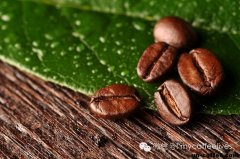There is a place in China called Yunnan, where there is beautiful "Lanshan" coffee.
I haven't paid attention to the so-called Blue Mountain storm recently, and I don't have any feeling, but I've actually heard a long time ago that the coffee taste of Yunnan in China has the laudatory name of Sailan Mountain. Whether it's hype or fact, at least we have homemade coffee in China. However, due to the lack of international evaluation standards, or other reasons, perhaps the quality is really poor, Yunnan coffee has not "made a difference" in the international arena, winning any "honorary title" for Chinese coffee.
I have also discussed Yunnan coffee in China with several senior coffee people. I have both positive and negative comments on the flavor of Yunnan coffee, but most of them think that Yunnan coffee has a thin taste and is not mellow enough, or as the saying goes, it is relatively watery and lacks texture. I have drunk a lot of Yunnan coffee myself. I feel OK for the flavor of Yunnan beans, but as everyone said, there is a feeling of water. In addition, after doing their own baking, I also found some characteristics of Yunnan beans, such as the texture is very soft, silver skin treatment is not complete, resulting in the baking is more difficult to control, the whole process is losing silver skin.
But in any case, there is no doubt that the varieties introduced from Yunnan beans are superior varieties of coffee, which we often say that Yunnan small grains are Typica, and the Blue Mountains of Jamaica are also iron pickups. Different flavors are formed due to different regions. Now in Yunnan, Nestl é, Starbucks and Maxwell are all trying or have set up their own coffee farms to achieve the "localization" of kilograms of coffee, so as to reduce costs. I think Chinese coffee. Yunnan coffee is still very promising.
Important Notice :
前街咖啡 FrontStreet Coffee has moved to new addredd:
FrontStreet Coffee Address: 315,Donghua East Road,GuangZhou
Tel:020 38364473
- Prev

Coffee Dictionary-- explanation of Coffee Industry terms
About coffee beans: * Coffee cherry: the fruit of a coffee tree, named because its rind is bright red and its shape is very similar to cherries. * round beans: when the coffee fruit is growing, one of the two seeds develops very well, and the other seed is eaten so that the coffee bean that should be oval becomes round. * Elephant beans: bigger than ordinary coffee beans and usually taste
- Next

Al's Rule extracted by Espresso (Al-Fe rule: sweet spot formula)
Al Critzer's understanding of Espresso extraction has become the most common concept of Espresso in Europe and the United States. The translation is as follows: starting with the result that 30cc/ 30sec gets a perfect Espresso. These two values of course depend on beans, and the differences in baking method, baking degree and formula ratio will naturally lead to changes in the reference point. The extraction quantity and extraction time are mutually related.
Related
- Beginners will see the "Coffee pull flower" guide!
- What is the difference between ice blog purified milk and ordinary milk coffee?
- Why is the Philippines the largest producer of crops in Liberia?
- For coffee extraction, should the fine powder be retained?
- How does extracted espresso fill pressed powder? How much strength does it take to press the powder?
- How to make jasmine cold extract coffee? Is the jasmine + latte good?
- Will this little toy really make the coffee taste better? How does Lily Drip affect coffee extraction?
- Will the action of slapping the filter cup also affect coffee extraction?
- What's the difference between powder-to-water ratio and powder-to-liquid ratio?
- What is the Ethiopian local species? What does it have to do with Heirloom native species?

